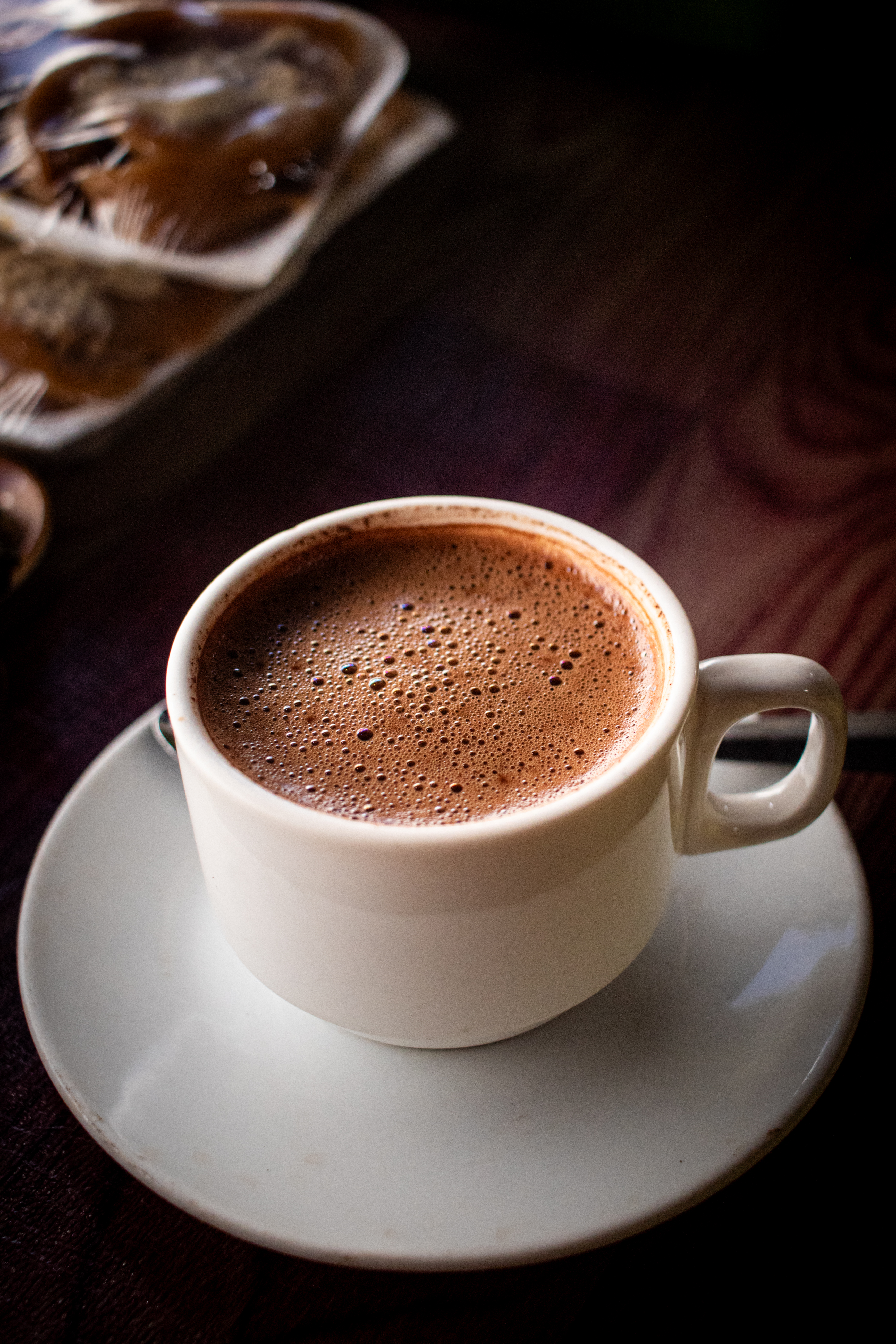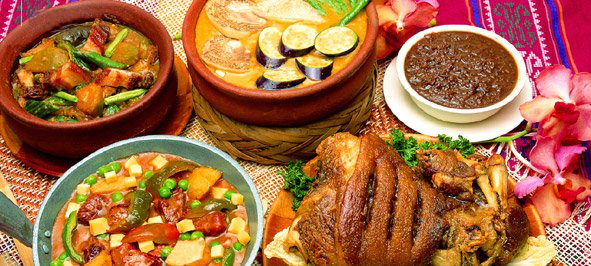|
Tablea
''Tsokolate'' ( ), also spelled ''chocolate'', is a native Cuisine of the Philippines, Filipino thick hot chocolate drink. It is made from ''tabliya'' or ''tablea'', tablets of pure ground roasted Theobroma cacao, cacao beans, dissolved in water and milk. Like in Spanish and Mexican versions of hot chocolate, the drink is traditionally made in a ''tsokolatera'' and briskly mixed with a wooden baton called the ''Molinillo (whisk), molinillo'' (also called ''batidor'' or ''batirol''), causing the drink to be characteristically frothy. ''Tsokolate'' is typically sweetened with a bit of ''muscovado'' sugar, and has a distinctive grainy texture. ''Tsokolate'' is commonly consumed at breakfast with traditional ''kakanin'' delicacies or ''pandesal'' and other types of traditional Filipino pastries. It is also popular during Christmas in the Philippines, Christmas season in the Philippines, particularly among children. Names ''Tsokolate'' is also known as ''suklati'' in Kapampangan la ... [...More Info...] [...Related Items...] OR: [Wikipedia] [Google] [Baidu] |
Sikwate
''Tsokolate'' ( ), also spelled ''chocolate'', is a native Filipino thick hot chocolate drink. It is made from ''tabliya'' or ''tablea'', tablets of pure ground roasted cacao beans, dissolved in water and milk. Like in Spanish and Mexican versions of hot chocolate, the drink is traditionally made in a '' tsokolatera'' and briskly mixed with a wooden baton called the '' molinillo'' (also called ''batidor'' or ''batirol''), causing the drink to be characteristically frothy. ''Tsokolate'' is typically sweetened with a bit of ''muscovado'' sugar, and has a distinctive grainy texture. ''Tsokolate'' is commonly consumed at breakfast with traditional ''kakanin'' delicacies or ''pandesal'' and other types of traditional Filipino pastries. It is also popular during Christmas season in the Philippines, particularly among children. Names ''Tsokolate'' is also known as ''suklati'' in Kapampangan; ''sikulate'' in Maguindanao; and ''sikwate'' or ''sikuwate'' in Visayan languages. All are ... [...More Info...] [...Related Items...] OR: [Wikipedia] [Google] [Baidu] |
Cuisine Of The Philippines
Filipino cuisine is composed of the cuisines of more than a hundred distinct ethnolinguistic groups found throughout the Philippine archipelago. A majority of mainstream Filipino dishes that comprise Filipino cuisine are from the food traditions of various ethnolinguistic groups and tribes of the archipelago, including the Ilocano, Pangasinan, Kapampangan, Tagalog, Bicolano, Visayan, Chavacano, and Maranao ethnolinguistic groups. The dishes associated with these groups evolved over the centuries from a largely indigenous (largely Austronesian) base shared with maritime Southeast Asia with varied influences from Chinese, Spanish, and American cuisines, in line with the major waves of influence that had enriched the cultures of the archipelago, and adapted using indigenous ingredients to meet local preferences. "Philippine Cuisine." ... [...More Info...] [...Related Items...] OR: [Wikipedia] [Google] [Baidu] |
Champorado
Champorado or tsampuradoVirgilio Almario, Almario, Virgilio, et al. 2010. ''UP Filipino Dictionary, UP Diksiyonaryong Filipino'', 2nd ed. Anvil Publishing, Anvil: Pasig. (from from ''champurrar'' 'to mix') is a sweet chocolate rice porridge in Cuisine of the Philippines, Philippine cuisine. Ingredients It is traditionally made by boiling Glutinous rice, sticky rice with ''tablea'' (traditional tablets of pure ground roasted cocoa beans). It can be served hot or cold, usually for breakfast or ''merienda'', with a drizzle of milk (or coconut milk) and sugar to taste. It is usually eaten as is, but a common pairing is with salted dried fish (''daing'' or ''Daing, tuyo''). ''Tinughong'' is a variant of champorado in the Bisayan languages, Visayan-speaking regions of the Philippines. It is usually made by boiling sticky rice with sugar instead of tablea. Coffee or milk are sometimes added to it. A popular new variant of champorado is ''ube champorado,'' which has a purple yam ('' ... [...More Info...] [...Related Items...] OR: [Wikipedia] [Google] [Baidu] |
Christmas In The Philippines
In the Philippines, Christmas (; ) is a major annual celebration, as in most countries of the Christian world. It is celebrated as a public holiday in the country on December 25, concurrent with other countries. As one of the two predominantly Catholic countries in Asia (the other one being East Timor), the Philippines celebrates the world's longest Christmas season (), spanning what it refers to as the "ber months". With Christmas music played as early as August, the holiday season gradually begins by September, reaches its peak in December during Christmastide, and concludes within the week after New Year's Day; however, festivities may last until the third Sunday of January, the feast day of the Santo Niño. Liturgically, the Christmas season is observed by the Catholic Church from the first day of Advent (the fourth Sunday before Christmas) to Three Kings' Day, which falls on the Sunday between January 2 and 8. Etymology and nomenclature In Filipino and other Philipp ... [...More Info...] [...Related Items...] OR: [Wikipedia] [Google] [Baidu] |
Visayan Languages
The Bisayan languages or Visayan languages are a subgroup of the Austronesian languages spoken in the Philippines. They are most closely related to Tagalog and the Bikol languages, all of which are part of the Central Philippine languages. Most Bisayan languages are spoken in the whole Visayas section of the country, but they are also spoken in the southern part of the Bicol Region (particularly in Masbate and Sorsogon where several dialects of Waray are spoken), islands south of Luzon, such as those that make up Romblon, most of the areas of Mindanao and the province of Sulu located southwest of Mindanao. Some residents of Metro Manila also speak one of the Bisayan languages. Over 30 languages constitute the Bisayan language family. The Bisayan language with the most speakers is Cebuano, spoken by 20 million people as a native language in Central Visayas, parts of Eastern Visayas, and most of Mindanao. Two other well-known and widespread Bisayan languages are Hili ... [...More Info...] [...Related Items...] OR: [Wikipedia] [Google] [Baidu] |
Pitcher (container)
In American English, a pitcher is a container with a spout used for storing and pouring liquids. In English-speaking countries outside North America, a jug is any container with a handle and a mouth and spout for liquid – American "pitchers" will be called jugs elsewhere. Generally a pitcher also has a handle, which makes pouring easier. Ewer is an older word for a pitcher or jug of any type, though tending to be used for a vase-shaped pitcher, often decorated, with a base and a flaring spout. The word is now unusual in informal English describing ordinary domestic vessels. A notable ewer is the America's Cup, which is awarded to the winning team of the America's Cup sailing regatta match. Etymology The word ''pitcher'' comes from the 13th-century Middle English word ''picher'', which means earthen jug. The word ''picher'' is linked to the Old French word ''pichier'', which is the altered version of the word ''bichier'', meaning drinking cup. The word's origin goes as fa ... [...More Info...] [...Related Items...] OR: [Wikipedia] [Google] [Baidu] |
Dumaguete Sta Monica Beach Club - Suman Mangga Tsokolate 2
Dumaguete, officially the City of Dumaguete (; ; ), is a component city and capital of the province of Negros Oriental, Philippines. According to the 2020 census, it has a population of 134,103 people. It is the most populous city and the smallest city by land area in Negros Oriental, as well as one of the two regional centers in Negros Island Region (the other one is Bacolod). Dumaguete is a university city with four large universities and several colleges, attracting students of the province and students from across the Visayas and Mindanao. The city is best known for Silliman University, the first Protestant and American university in the country and in Asia. Schools in Dumaguete include 18 public elementary schools and eight public high schools. Dumaguete is bounded by the towns of Bacong, Sibulan, and Valencia. The power source of the city comes from the geothermal power plant in Valencia. Etymology "Dumaguete" was coined from the Cebuano word , which means "to snatc ... [...More Info...] [...Related Items...] OR: [Wikipedia] [Google] [Baidu] |
Porridge
Porridge is a food made by heating, soaking or boiling ground, crushed or chopped starchy plants, typically grain, in milk or water. It is often cooked or served with added flavourings such as sugar, honey, fruit, or syrup to make a sweet cereal, or it can be mixed with spices, meat, or vegetables to make a Savoury (dish), savoury dish. It is usually served hot in a bowl, depending on its consistency. Oat porridge, (known as oatmeal in North America) is one of the most common types of porridge. Gruel is a thinner version of porridge and congee is a savoury variation of porridge of Asian cuisine, Asian origin. Type of grains The term "porridge" is used in British English (Britain, Ireland, Australia and New Zealand) specifically for oatmeal. This is a hot mixture of oatmeal or oats slowly cooked with water or milk. It is typically eaten for breakfast by itself or with other ingredients, including salt, sugar, fruit, milk, cream, or butter. Other grains used for porridge include ... [...More Info...] [...Related Items...] OR: [Wikipedia] [Google] [Baidu] |
Glutinous Rice
Domestication syndrome refers to two sets of phenotypic traits that are common to either domesticated plants or domesticated animals. Domesticated animals tend to be smaller and less aggressive than their wild counterparts; they may also have floppy ears, variations to coat color, a smaller brain, and a shorter muzzle. Other traits may include changes in the endocrine system and an extended breeding cycle. These animal traits have been claimed to emerge across the different species in response to selection for tameness, which was purportedly demonstrated in a famous Russian fox breeding experiment, though this claim has been disputed. Other research suggested that pleiotropic change in neural crest cell regulating genes was the common cause of shared traits seen in many domesticated animal species. However, several recent publications have either questioned this neural crest cell explanation or cast doubt on the existence of domestication syndrome itself. One recent publica ... [...More Info...] [...Related Items...] OR: [Wikipedia] [Google] [Baidu] |
Chocolate Liquor
Chocolate liquor, also called cocoa liquor, paste or mass, is pure cocoa in liquid or semi-solid form. It is produced from cocoa bean nibs that have been fermented, dried, roasted, and separated from their skins. The nibs are ground to the point cocoa butter is released from the cells of the bean and melted, which turns cocoa into a paste and then into a free-flowing liquid. The liquor is either separated into (non-fat) cocoa solids and cocoa butter, or cooled and molded into blocks, which can be used as unsweetened baking chocolate. Like the nibs from which it is produced, it contains both cocoa solids and cocoa butter in roughly equal proportion. Its main use (often with additional cocoa butter) is in making chocolate. The name ''liquor'' is used not in the sense of a distilled, alcoholic substance, but rather the older meaning of the word, meaning 'liquid' or 'fluid'. The terms ''paste'' and ''mass'' are also commonly used. According to American legislation, chocolate liquo ... [...More Info...] [...Related Items...] OR: [Wikipedia] [Google] [Baidu] |
Tablilla
The tablillas are an alleged Medieval Spanish technique of torture Torture is the deliberate infliction of severe pain or suffering on a person for reasons including corporal punishment, punishment, forced confession, extracting a confession, interrogational torture, interrogation for information, or intimid ... for crushing the toes and fingers by means of pillories and wedges. Description and procedure The only writer to comment in detail on the torture of the tablillas may be paraphrased as follows: "The torture of the tablillas is rarely given, the subject trussed up as for the torture of water and cords; having not obtained confession, four palm-sized tablillas are brought, each with five narrow finger-width or toe-width holes, and to give grave pain they hammer a wedge, bit by bit, between the hole and the trapped finger or toe, one after the other; and the fingers and toes are so crushed and beaten, and the torture quite remarkably savage that rarely do the judges exh ... [...More Info...] [...Related Items...] OR: [Wikipedia] [Google] [Baidu] |








